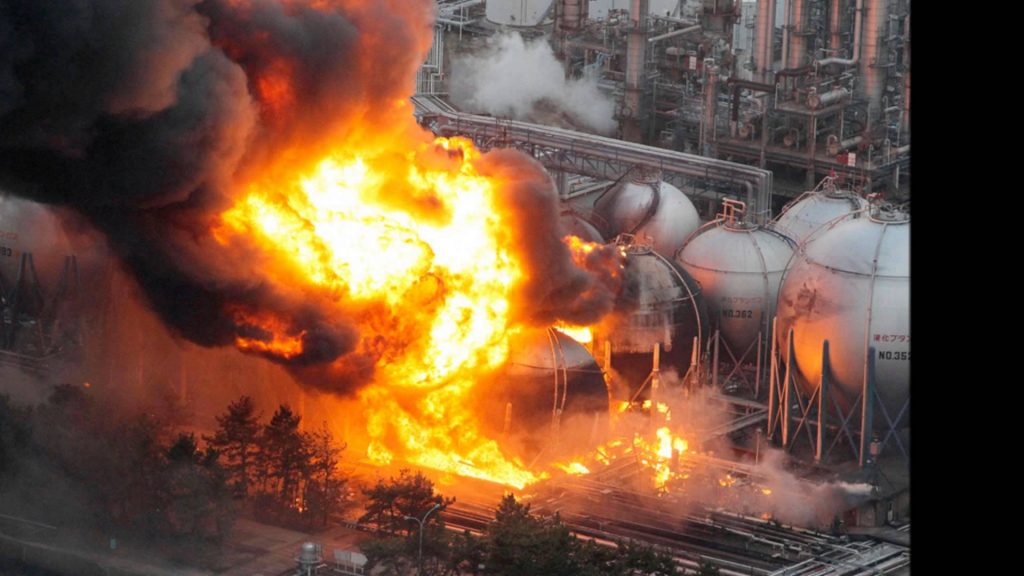Natural disasters are very common but tragic events around the world. From earthquakes to tornadoes, geological disasters can cause increasingly damaging effects, affecting the landscape and those who find themselves there. But when these events are combined with man-made artifacts, the effects might be even greater. An example of this is the Fukushima Disaster in Japan, the worst nuclear disaster since the 1986 Chernobyl incident.1 But the cause of this horrific disaster wasn’t particularly a man-made event. In fact, it all started with a wave.

On March 11, 2011, an earthquake with a magnitude 9.0—the worst to ever hit Japan—hit the country. It was such a powerful catastrophe, that Japan’s main island, Honshu, was permanently moved more than two meters to the east. As the earthquake gained momentum, waves up to 40 meters began crushing the country’s coast. The effects of the earthquake and the waves were too much for the Japanese. More than 20,000 people died or went missing and hundreds of thousands more lost their homes.2 But the worst was yet to come. Fifty minutes after the initial earthquake, a ten-meter high sea wall hit the Fukushima Daiichi (Number One) nuclear power plant. The water flooded the plant’s emergency power generators, knocking vital cooling systems offline, triggering a meltdown of reactor fuel rods. These then leaked deadly radiation into the coastal atmosphere of Japan. With the cooling systems not working, hydrogen gas built up in the reactor buildings, causing several hydrogen explosions in the following days of the earthquake.3

Because of the highly toxic radioactive material that leaked to the surrounding areas of the power plant, the government began to evacuate 80,000 people from a twelve-mile radius. Technicians turned to several things to try to cool the nuclear fuel, like using fresh water, seawater, and injecting nitrogen into the reactor containment buildings to prevent further explosions.4 But despite the efforts to try to help the people of Honshu, the government didn’t tell the people the truth. The official statistics of the event and even the admittance that the meltdown had taken place weren’t disclosed until eighty-eight days later.5
It was estimated that more than 800,000 tons of highly-radioactive material sat near the accident, which was slowly getting into the ground and moving towards the ocean. Although many people were evacuated, there were still many that couldn’t leave. The government installed temporary housing that was intended to house tens of thousands of people after the disaster for twenty-four months. But five years after the disaster, thousands of people were still living where they were surrounded by the radioactive material. Many of those who remained were the elderly and low-income families who had few options to move away.6

Several months after the disaster, people in other parts of Japan began rallying to help these people and bring an end to nuclear power plants in Japan. This pushed forward for the closure of all of the other nuclear plants in Japan for maintenance and inspection.7 These protests also pressured the government to issue a report on the disaster at Fukushima. This report criticized TEPCO (the Tokyo Electric and Power Company) for failing to address concerns about safeguards at the plant. This report also included information about how TEPCO officials had ignored engineers’ concerns that a seawall constructed to protect against major tsunamis as they had seen on March 11 was not sufficient. The report additionally criticized safety regulators for not implementing proper safety measures and for failing to adopt global nuclear safety standards.8 This was really important for the Japanese because TEPCO had always emphasized that the nuclear generators were “fail-safe,” that the facility was completely earthquake resistant and that the reactors would be able to withstand a major tremor.9
Five years after the disaster in Japan, several policies were changed to address the rising concerns of the Japanese population regarding nuclear power plants. The major decision of this kind was the decision to phase-out nuclear power plants during the 2030s as part of Innovative Strategy for Energy and the Environment adopted by the cabinet of the Democratic Party of Japan (DPJ).10 TEPCO is still facing criticism regarding the amount of nuclear material that was leaked into the environment and it is estimated that cleanup operations could take up to forty years.11
- Will Ripley, Junko Ogura, and James Griffiths, “Fukushima: Five Years after Japan’s Worst Nuclear Disaster,” CNN, March 11, 2016, sec. World. ↵
- Encyclopedia Britannica, 2018, s.v. “Fukushima Accident.” ↵
- New World Encyclopedia, 2017, s.v. “Fukushima nuclear disaster.” ↵
- New World Encyclopedia, 2017, s.v. “Fukushima nuclear disaster.” ↵
- Will Ripley, Junko Ogura, and James Griffiths, “Fukushima: Five Years after Japan’s Worst Nuclear Disaster,” CNN, March 11, 2016, sec. World. ↵
- Will Ripley, Junko Ogura, and James Griffiths, “Fukushima: Five Years after Japan’s Worst Nuclear Disaster,” CNN, March 11, 2016, sec. World. ↵
- New World Encyclopedia, 2017, s.v. “Fukushima nuclear disaster,” ↵
- Encyclopedia Britannica, 2018, s.v. “Fukushima Accident.” ↵
- Akira Nakamura and Masao Kikuchi. “What We Know, and What We Have Not Yet Learned: Triple Disasters and the Fukushima Nuclear Fiasco in Japan,” Public Administration Review 71, no. 6 (2011): 894. ↵
- Rie Watanabe, “After the Fukushima Disaster: Japan’s Nuclear Policy Change from 2011 to 2012,” Review Of Policy Research 33, no. 6 (2016): 623. ↵
- Alexis Dudden, “The Ongoing Disaster,” The Journal of Asian Studies 71, no. 2 (2012): 349. ↵



111 comments
Devin Ramos
I was in elementary school when this earthquake hit Japan and to me as a kid this was the craziest thing that I have ever seen and even to this day the idea of the whole island of Japan being moved two meters is crazy. And how the tsunami devastated the country’s coast. But to me Japan even though they had to help their citizens with natural disaster relief they should have done a better job with containing the radiation that escaped from the reactors. I saw a map that showed how far the radiation from the reactors had gone and it showed it went all the way to California.
William Rittenhouse
This is such a tragic event that could have ended a lot better had safety measures been taken into account. The casualties from the waves were bad enough. I’m not sure if I could ever understand why proper safety measures were not taken into place, especially in a place like Japan where earthquakes and hurricanes are inevitable. I at least hope they learned their lesson and will do whatever they can to ensure the safety of their own citizens.
Eloisa Sanchez Urrea
Although the Fukushima Disaster was not caused my man, we were still an indirect cause. The technological advances we have made in the past decades come with a cost and this is a perfect example. Nuclear plants like this one put us at a very vulnerable position especially during natural disasters. This was a very insightful article in which we were able to see the causes, effects, and reaction toward this disaster.
Marina Castro
I remember when it hit the news that there had been an earthquake in Japan. Everyone was so surprised and scared of the amount of damage the event had caused. Reading about the nuclear explosion and its effects is so overwhelming. It must have been very scary for Japanese people to go through a catastrophe like that. Even today the damage caused can be seen.
Greyson Addicott
I vaguely remember this tragedy, but because it had very little effect on me, I never truly knew about the damage it caused to mainland Japan until now. Texas, after what happened last year, also knows what the Japanese people went through in 2011. Nuclear energy is a very touchy subject, and while it provides clean and efficient power 10 times better than coal, we should always be aware of its inherent destructive power. The waste it produces is also a problem, but it wasn’t the waste that destroyed a significant chunk of Japan.
John Berka
I remember watching this story on the news in High School and knowing this was terrible, but it never really sank in because it was so far away from me. As I heard more and more about it, and after reading this article it blows me away how severe this disaster truly was! I mean if an earthquake, tsunami, and nuclear spill wasn’t bad enough, the Japanese government would have prevented a lot of deaths if they made sure the sea walls were sufficient enough to stop the waves or at least slow them down. The negligence of TEPCO is what made the death toll as high as it was and that is truly tragic.
Sarah Nguyen
Previously, I’ve interned at an energy company. There, I learned about all types of energy, and even learned that Nuclear Power Plants are one of the most environmentally friendly way to produce energy. However, the risk that they pose when not properly maintained is catastrophic, as demonstrated by Fukushima and Chernobyl. I had no idea that the reason for the nuclear disaster wasn’t only because of the tsunami, but because of their decision to ignore the engineers and not maintain their plant. This reminds me of the BP oil spill – which could have been prevented had they made sure all their equipment was updated instead of ignoring it because updates were too expensive. The author of the article did a great job providing insight on the causes of Fukushima and how the people of Japan reacted in protest to the disaster as well. Great article!
Yadira Chavez
It seems to me that the Fukushima Disaster’s full destruction will never be known to the public, but the information that has been released so far is so catastrophic! The article is very informative of the details that are not widely understood, such as sub-par policies that could have very well prevented Fukushima’s meltdown. Thousands of lives were changed forever because of this neglect of safety and that is terrifying.
Maxx Arizmendi
I remember the earthquake of Japan, but this was the first time that I found out about the Fukushima power plant disaster. It is sad that this nuclear plant was destroyed and it affected thousands and thousands of people who lived near the area. This made the death toll of those who died in the earthquake even higher, since it added on to the number of deaths. I found this article to be interesting to read.
Caden Floyd
It’s crazy to think of the things the government can get away with such as not disclosing information until eighty eight days later. However, I was glad to see that the people of Japan were all uniting, supporting, and helping one another in a time of need. I had never even heard about this disaster before, but this article is a very good source of information on the subject. The fact that the whole island moved two meters to the east shows how huge this earthquake was. At least TEPCO is starting to clean up their act after being responsible for so much radioactive material was released.